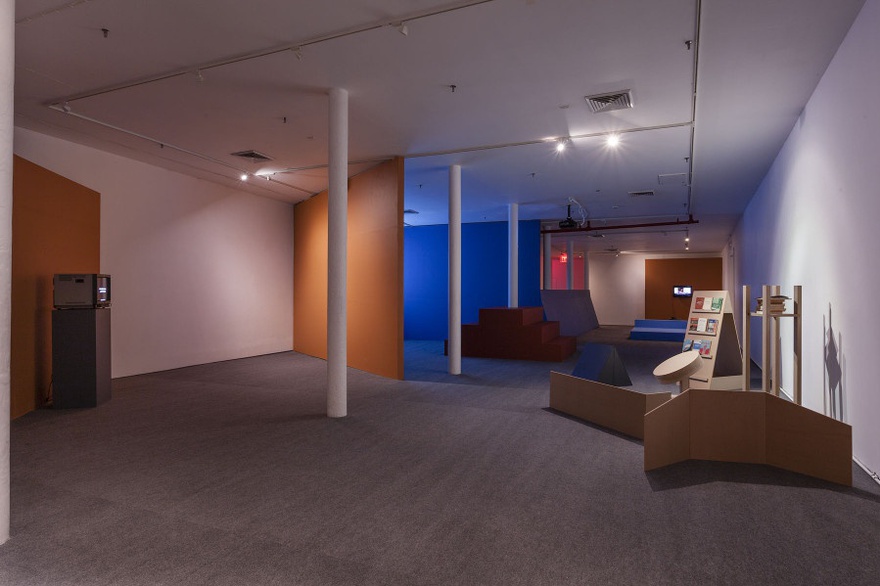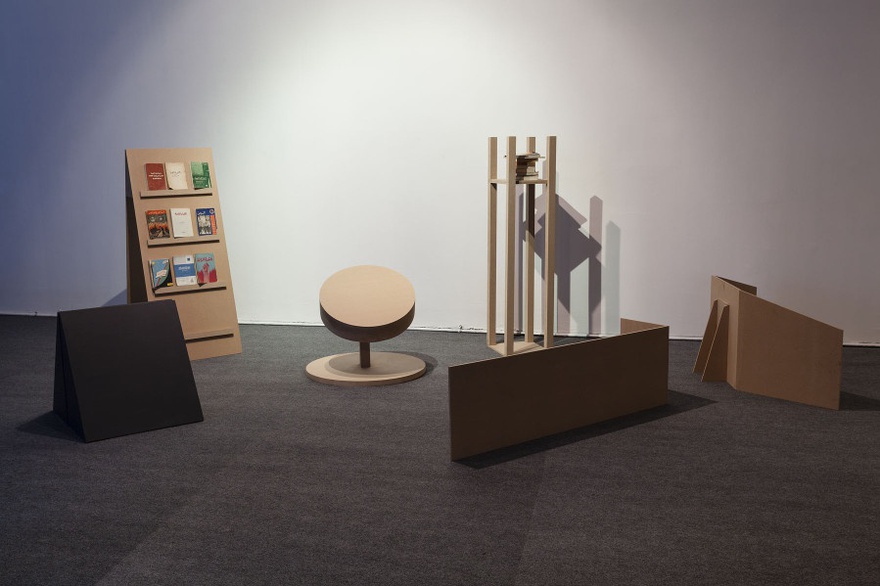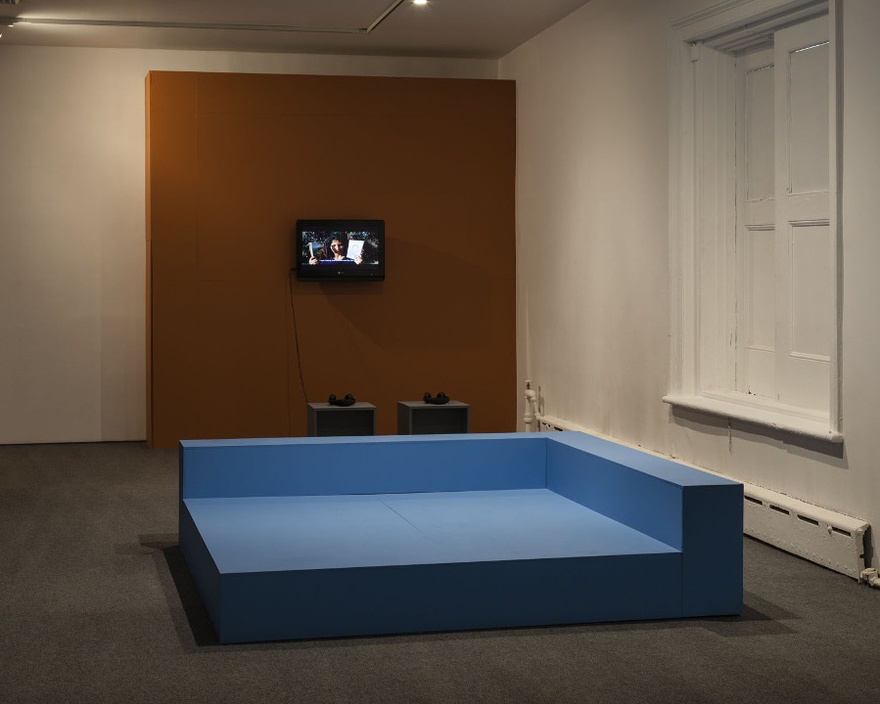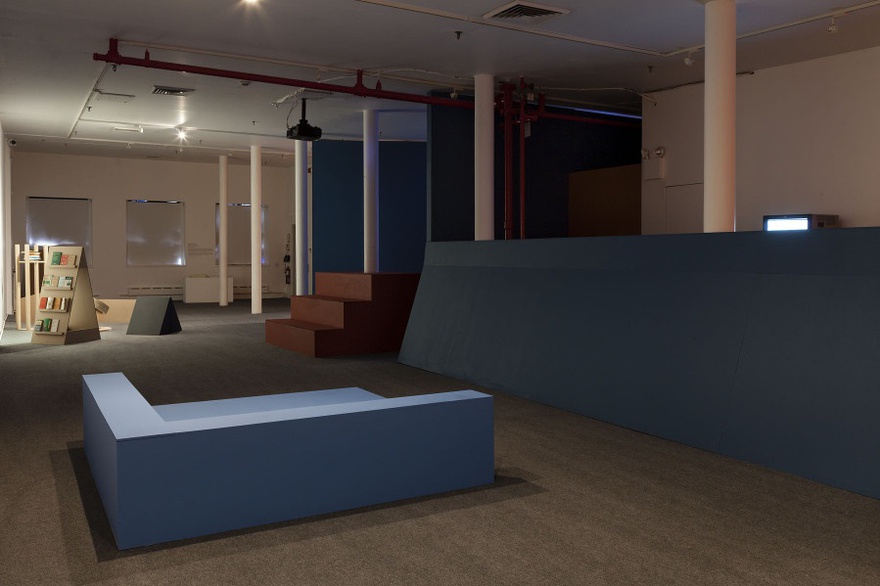Interviews
Accumulative Processes
Marwa Arsanios in conversation with Fawz Kabra
Marwa Arsanios' practice involves performance, installation, film, animation and publications. Through her research and work she deconstructs and appropriates various socio-political narratives of the Middle East that relate to popular culture and the rise and fall of political ideologies. Her recent commission Notes for a Choreography (2015) at New York's Art in General brings together Marwa's previous works and new film OLGA's NOTES, all those restless bodies (2013–2014) in an experimental sculptural installation that allows her to navigate performance, film and text that stagger between different time-spaces. In this interview, Arsanios and Fawz Kabra touch upon several previous projects and connect points of view on feminism, Al-Hilal magazine publications in the 50s–60s, performance, and destroyed bodies and architectures that mark the remnants of violence induced on the human body by modernization.
Fawz Kabra: What is the seed of interest that brings you to dance and performance? Did you grow up with these practices?
Marwa Arsanios: No I didn't personally grow up with dance but I guess it is one of my favourite things to do, whether in a class or at a party. As a lot of my work is done while sitting on a computer or at a table or simply while sitting, I guess dance gives me another form of cognitive awareness of my body or another consciousness, which makes me think of ideas differently, maybe in a more physical or bodily way.
I seriously started thinking about performance with the long-term research I did on Al-Hilal magazine, which I will discuss in greater detail later. I was interested in using text and language in a performative manner and thinking of reading as a political act in terms of the decisions you make: what do you read and how do you read it. These decisions, when made public, could have some kind of political impact on knowledge and knowledge production. So I was thinking of text-based performances as a way to activate those political decisions and as a way to think about reading.
The film OLGA's NOTES, all those restless bodies came from the research I was doing with the magazine Al-Hilal and, more specifically, their collection from the 1950s and 60s. The magazine is issued in Egypt and was nationalized in the 60s under Nasser's regime. I came across an article that was presenting the newly-built ballet dance school in Cairo and was struck by the use of language. It was literally describing the school as 'the new industry of the body' and ballet becoming this dance that will break with folklore and produce the 'new modern body'.
FK: The name 'Olga', which also belongs to your grandmother, is present in a couple of your works. How has your grandmother's work been an inspiration to your own? I am also curious about your family history in relation to this material?
MA: OLGA's NOTES, all those restless bodies is named after a ballerina, not after my grandmother, who was also called Olga. But another performance Karl and Olga a Brief Encounter (2012) is named after her. She encounters Karl Marx and talks with him about her unaccomplished career as an artist and her struggles with the conditions of artistic production. It is a fiction, obviously, but I was trying to think about the struggles that a woman from her generation could have gone through and the compromises they had to make if they were ambitious and wanted to emancipate themselves from the patriarchal family structures of husbands and fathers. Of course, I am not generalizing and it changes according to the class one is coming from. But I imagined a middle class woman wanting to become an artist and having to think through and go through all the constraints and obstacles.
FK: Can you elaborate on the research that serves as the historical backstory, as well as the theoretical perspective, behind Notes for a Choreography?
MA: The exhibition at Art in General came about in dialogue with the director, Anne Barlow. It had a previous iteration at Kunsthalle Lissabon (2015) and the new work, OLGA's NOTES, all those restless bodies, was co-commissioned by both institutions. We decided to put the new work in conversation with some older works that deal with choreography in different ways, whether through space or through the ways of filming the image and editing. On another level, the new film is also connected to the research on Al Hilal magazine so we decided to include two other works that are part of this research: the library and the film Have You Ever Killed a Bear or Becoming Jamila (2012–2013). In this way we were also giving context to the new video. In fact my work is very accumulative or perhaps I have an accumulative process. So sometimes it is important to see all the different pieces together.
FK: I find that bringing up a magazine such as Al Hilal, one of Egypt's foremost social and political magazines that addressed modernization, nation-building, colonialism, and Gamal Abdul Nasser's socialist and nationalistic project (in the 1950–60s), very intriguing. Can you tell me about how mainstream, marginal, or avant-garde this publication was during different points of time over the last century?
MA: I guess I can tell you about the collection I worked with that concentrated on the 50s and 60s – and I have to say that three years ago, when I first started reading the different issues, I didn't always feel the gap in time. By this I mean that some of the ideas were still a little closer to the present. What happened after 2011 with the uprisings is that some discourses strongly re-emerged such as the leftist socialist, anti-colonial discourses, but of course with a new language, and some others felt really old and dead just like the old yellow paper of the magazine. But about the 1950s and 60s collection, I can say that it was a mainstream magazine that was very popular in the Arab world and had a wide readership in the leftist circles.
FK: What do you think are the contested issues that have come to light from this narrative of modernization, pan-Arabism or Arab Nationalism? And how do you interpret this history today through your work and particularly through performance?
MA: I think any kind of nationalism or nation-state building comes with violence that excludes difference in order to form some kind of oneness. So this very violent process is at the core of modern nation-state building. Pan-Arabism was also another hegemonic project that was obviously built upon an anti-colonial sentiment and struggle. But in other political terms it was Nasser's expansionist project and perhaps another form of colonialism. In that sense I guess that the very idea of the modern nation-state would be contested. In the Arab countries, many of those post-colonial nations turned into dictatorships especially after the 1967 defeat.
These nations were also built around the model of the patriarchal family: the father as the beloved head of the nation who cannot be contested. For example, in the case of feminist struggles and movements, it is true that women were given more space in the public sphere. But this was also because they needed more labour force. Any feminist movement that was not following a certain state policy and project was immediately marginalized. Any feminist movement that brought up state criticism was shut down forcefully. Perhaps I started dealing with these issues in Have You Ever Killed a Bear or Becoming Jamila – the problems of a feminism that was sponsored and driven by state policies.
FK: Moving on to dance, can you talk about your process of collaboration with dancers?
MA: Yes, in fact I had very long discussions and working sessions with one of the dancers, Sandra Iche, the one who re-enacts Yvonne Rainer's classic, Trio A (1966). And then there's Alia Hamdan, another dancer from Beirut, who joined our discussions. We also had some reading sessions where we talked a lot about dance as an experience from the point of view of the dancers/interpreter, dance schools, trainings and so on. I also attended classes with most of the dancers in the film. Some parts of the script came out of our discussions. So it was a long process before I started shooting.
FK: I am also curious about the video element in your collaboration with performers, one that also reflects on the performance of the body. Can you elaborate on the filmmaking process when it comes to working with performance?
MA: Actually the script was intended as a performance first. This is how I worked with Have You Ever Killed a Bear or Becoming Jamila. I first wrote a script for a performance that I later turned into a film. The motivation to turn it into a film is still not one hundred per cent clear to me but I guess I was not fully satisfied with it as a performance alone. Or maybe because it is not a medium I am totally comfortable with – since I come from visual arts background I was not used to the shock you get when you work for a long time on a piece and then you perform it in a one-night event and the day after you don't have much to take with you except for the script and some images. So the immaterial aspect of performance made me very uncomfortable. But I really like this about it, the discomfort, but also the immediacy, the proximity with the audience – the fact that you have to be there otherwise you will miss it.
It's the same with Olga's Notes – I guess I imagined the script to be read while the dancers perform to it with certain video elements coming in at some point. But the fact that I decided to do it as a video first was another way of working, as I will do it as a performance next. I guess I am always thinking about how these media feed into each other and push each other. I guess all my works in the past three or four years have been about these tensions between performance, film and text. By jumping from one media to the other you reveal the different processes in these time-based media.
FK: How do you connect dance and labour in your works? Quoting from the description about the work, how do you see OLGA's NOTES, all those restless bodies operating as a message on 'the violence of state projects and nation-state building that accompanies a capitalist ideology and a consumerist approach to the human form'?
MA: I guess this is most apparent, or most literal, with Jasmine the pole dancer. In fact, pole dancing and even more so in the case of Jasmine – a migrant worker who is working inside a very closed informal economy – puts dance into the realm of a 'job' or brings it back to the idea of material labour. Each movement has a wage and the whole dance is an accumulation of wages. The dance is a series of movements. Perhaps this applies to the other dancers as well, but as soon as something enters the realm of art it has another value and it is valued differently – for example, all the conceptual work, the thinking behind the piece and the choreography, the cognitive labour… how do you value all of that?
In the case of pole dance, the relationship between labour, body, and consumption is much more obvious. Not to say that an art piece or choreography is not consumed through the body of the dancers, the set, the music and so on – it is also a consumable good and I have actually talked with the dancers about the discomfort of knowing that your body is the element of consumption in a dance choreography and the discomfort of being filmed. I think it is important to acknowledge that as a filmmaker you are already imposing a certain voyeuristic relationship with the dancer and the potentiality of consumption. But we should not forget the pleasure that can come out of exhibiting one's own body and dancing for an audience. There is a sense of exhibitionism in this whole game. But once you acknowledge it you can start shifting the dynamics around.
FK: In your video, one woman performs Yvonne Rainer's Trio A, while Jasmine is at the stripper pole, and a third forgets her part in a harem dance and instead improvises. How does this semantic dichotomy operate within the context of 1960s Egypt and your starting point for the project where you used Al-Hilal magazine's article from January 1963 that introduces the establishment of a ballet school in Cairo (part of Nasser's plans for Egypt's reform and modernization)?
MA: I guess the script departs from the article that you mentioned but then goes somewhere else. It delves into dance because I also started working with the dancers and trying to understand the different dance schools they came from. But the choice to work with the five dancers in the film is of course related to the initial idea of the production of the modern body through dance. Perhaps I wanted to look at this idea with the different dancers within their own schools of dance.
FK: As a follow up to that, I am curious of your opinion about the fact that representations of modern emancipated women in Egyptian cinema of the time were usually characters who used their sexualized body as a source of power and eventual demise (for example, Hind Rostom or Fatima Ahmad Kamal). Is there any link to this idea of being modern and your use of dancers who are performing very particular pieces such as Trio A, a harem dance, or using a stripper pole (all three of which are loaded with meaning)? Also keeping in mind your work with the performance and video Have You Ever Killed a Bear or Becoming Jamila, where you once again use Al-Hilal magazine for its representation of the Algerian freedom fighter Djamila Bouhired (an icon of Algeria's war of independence) amongst representations of her in cinema to highlight the brief societal embrace of feminist politics. I suppose I am also interested in this dichotomy of what was happening in popular culture at the time and how you reinterpret this in your work.
MA: I think I am more interested in the actresses themselves than in the representation of women. With the industrial means of production such as print publications, cinema in Egypt became a new form of use and abuse of the female body; the sexualized object of desire that you could see all over the Al-Hilal magazine covers. All of the pictures of women posing were unrelated to the content, of course, but they just needed to have these 'attractions' on the cover. I guess modernities were violent towards the female body. They pushed it to the forefront as a consumable good to the spectacle, the vitrine, the magazine cover and the film; or pushed it backstage to the factory, the agricultural fields, the secondary jobs and the low-wage jobs; or to the back of the backstage – the free labour at home. Of course this depends on a lot of different factors such as class, race, or even if one fits into the beauty criteria of those jobs. So what would be more interesting for me now is to look at how these actresses, for example, dealt with the given conditions of their time and in turn used them to do something. I guess that in Have You Ever Killed a Bear or Becoming Jamila I was trying to break away from this idea of the representation of women but I was still very much inside of it as well. The difference is that if I had to redo this now I would look at it from another angle. But I think a lot of my work is some kind of mix between popular culture, TV series, magazines, rumours and other forms of more theoretical research.
FK: The relationship between body, subjectivity and politics are power dynamics that shape the way we navigate our social bodies and exercise our agency (or lack thereof) – how do you perceive the connections in between 'modernization of society' and 'modernization of the body'? What is the critical direction you are taking with these questions in relation to 1960s Egypt and the Middle East today. What is being said here, with hindsight included?
MA: I look at modernization as a violent process that allows the domination of certain groups over others: colonization; exploitation of certain people by the industries; the development of capitalism that allowed the enrichment of an already rich class; and the impoverishment of the already poor.
FK: I'd like to ask you about the rest of Notes for a Choreography. The animations in the exhibition were particularly intriguing. Can you tell me about them and why you chose to include them here?
MA: In the case of dance and animation you are looking at a series of movements or a series of frames. Each frame is a fraction of a second within the 24 frames per second movement. In that sense, thinking about dance through film is also thinking about film through dance.
My first encounter with moving image was through animation. I was studying drawing and most of my work was 2D hand-drawn animation. I was spending hours drawing one movement. So I guess I was thinking about movement as the image-movement and thought that this is an important link to dance and the film media that I am using: the movement of the performers, the dancers in space and decomposing the movement of the image itself.
FK: I am really drawn to your use of various narratives that emerge from urban architectures, crimes of passion, and political power and occupation. Can you tell me more about this?
MA: This was a period when I had moved to Beirut after three years away and I was somehow rediscovering the city. It was also a period when the repercussions of the reconstruction of Beirut's city centre had started to show in other parts of the city. Real estate was taking over and a lot of modern architecture was being torn down and replaced by high-rises. I was seeing this process happening and found an entry point to talk about it through urban myths and rumours that unfold the power struggles happening in the urban space.
FK: How about your history and fascination of working with various architectures in your art such as the demolished Carlton Hotel and the space ship on Acapulco Beach (in the Carlton Hotel Project [2008–2012] and the Acapulco Project [2009–2010]), now a refugee camp, both of which are located in Lebanon? Did this previous research influence your architectural decisions for the exhibition?
MA: Yes, it definitely did. I don't know how exactly but I started thinking about spatial installations within an exhibition differently.
FK: Should we see a link between the dancer's body in OLGA's NOTES, all those restless bodies and the destroyed body or destroyed ideology of a hotel – such as the Carlton – a site for pleasure and tourism?
MA: I like this link. I never really thought about it in that way but yes.
FK: How about the architecture of the show? It seems that it functions as both sculpture and armature for the works included.
MA: Yes, that is true. It is actually the first time that I did something like this, bringing all these different elements together: the platform for reading, the library and building up a structure in the space. I was thinking of the space as one thing that holds together the different works but that can also stand on its own and speak with the other structures such as the library and the platform. I don't know if it worked out or not or if it was necessary... I am still thinking about these questions.
FK: In this exhibition, as with several of your previous works, I find a tension between elements such as (re)enactment, the written word and the spoken word. Can you tell me what your intentions are with the use of these elements that work together yet also have an individualistic presence in the larger scheme of things?
MA: I guess this is what I really like about performance – it's this tension between language and body. Not to say that they are separate things but in a tension-relation.
FK: In Words as Silence Language as Rhymes (2012) you revisit Al-Hilal once again by creating two new books that pose questions about a long-gone era – the Middle East in the 1960s, Arab Nationalism, women's liberation and more. While with Olga's Notes you present an imagined conversation between yourself and your grandmother about her commitments to political causes among other topics such as language and collage. I cannot help but ask if there is an element of nostalgia here? Can you elaborate on these lines of thinking?
MA: Yes, maybe I also have a problem with this way of working today. But in the past few years I think that I was also building up a structure for myself, just like the architectural structural in the show. I was also looking for a way to think about more progressive political ideas, which I somehow found in this material. So looking at the past was also a way to project into the future, to find for myself a space to think outside hegemonic liberal ideas.
Marwa Arsanios is a visual artist based in Beirut, Lebanon. She completed her BA in Graphic Design from the Lebanese American University (2001), and obtained her MFA from Wimbledon College of Art, University of the Arts, London (2007). She has exhibited in London, Beirut, Athens, Oxford, Lisbon, Santiago de Chile, Rome and Damascus. Her work was shown at Art Dubai in the Bidoun Lounge (Art Park), at Forum Expanded at the Berlinale 2010, at the Homeworks V forum in Beirut and at Tokyo Wonder Site in Tokyo. Her videos have been screened at several festivals and events such as the Rio de Janeiro film festival in 2010, the e-flux storefront in New York, and most recently at the Centre Pompidou in Paris. She is a founding member of the artist organization, and research and project space 98weeks, and one of the organizers of the travelling exhibition project Platform Translation.



















